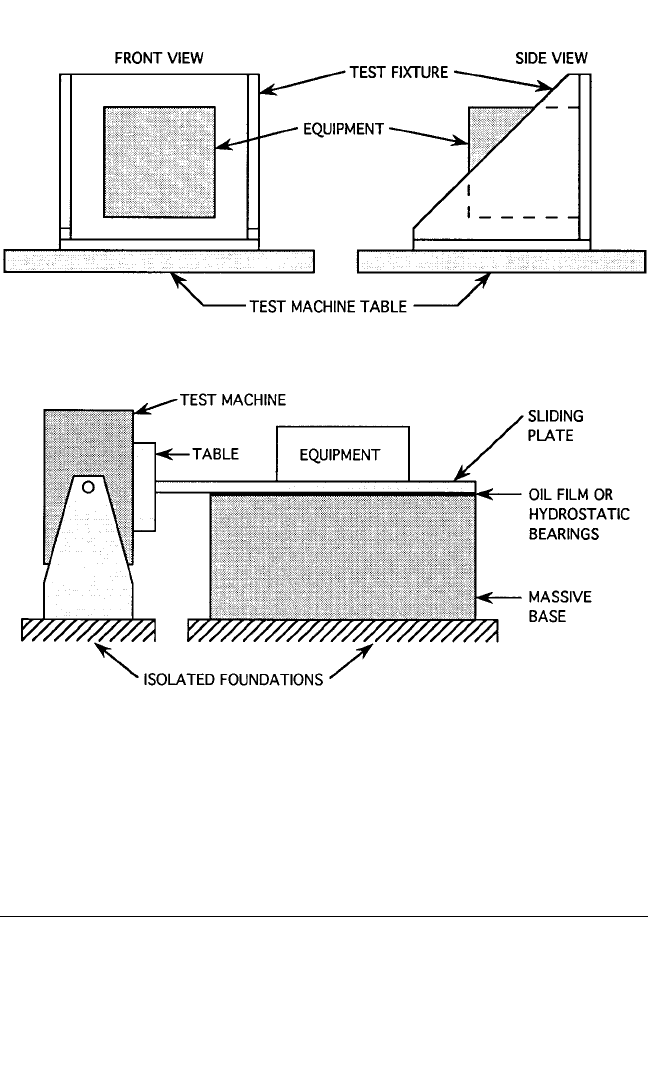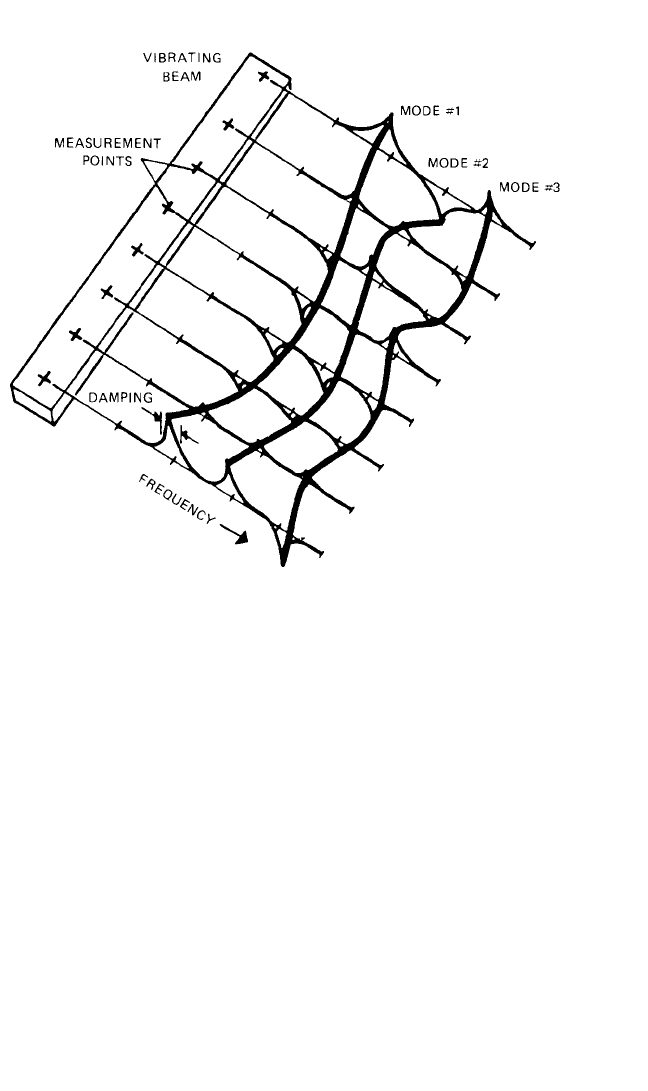Harris C.M., Piersol A.G. Harris Shock and vibration handbook
Подождите немного. Документ загружается.


determination depends heavily on the purpose of the test and sometimes on the
judgment of the purchaser of the equipment. Here are a few examples:
1. Since a qualification test is intended to identify design problems, failures during
the test that are clearly due to workmanship errors or material defects are usually
ignored, i.e., the equipment is repaired and the test is continued.
2. Since the test level for a highly accelerated qualification test is based upon a spe-
cific failure model, failures during the test that are not consistent with the failure
model should be carefully evaluated and ignored if they are determined to
involve a failure mechanism that is not time-dependent.
3. During durability tests of equipment, if a fatigue crack forms in the equipment
structure that does not propagate to a fracture, whether the fatigue crack consti-
tutes a failure or the length of the fatigue crack that constitutes a failure must be
specified.
4. During functional tests of electrical, electronic, and/or optical equipment, if there
is measurable deterioration in the performance of the equipment during the test,
the exact degree of deterioration that prevents the equipment from performing
its intended purpose must be specified.
TYPES OF EXCITATION
Shock tests are sometimes performed using specified test machines, but more often
are performed using more general test machines that can produce transients with a
desired shock response spectrum (see Chaps. 26 and 27). Although vibration envi-
ronments may be simulated by mounting the equipment in a prototype system and
reproducing the actual environment for the system, it is more common to apply the
vibration directly to the equipment mounting points using vibration testing
machines described in Chap. 25.
Random Tests. Random excitations are used to simulate random vibration in
those tests where an accurate representation of the environment is desired, specifi-
cally, qualification, reliability, and some acceptance tests. The most commonly used
random test machines produce a near-Gaussian vibration. If the actual environment
is random but not Gaussian, a Gaussian simulation is acceptable since the response
of the equipment exposed to the environment will be near-Gaussian at its resonance
frequencies, assuming the equipment response is linear; this is because equipment
resonances constitute narrow-band filtering operations that suppress deviations
from the Gaussian form in the vibration response of the equipment.
12
Sine Wave Tests. Sine wave excitations are used to simulate the fixed-frequency
periodic vibrations produced by constant-speed rotating machines and reciprocating
engines. Sine wave excitations are sometimes superimposed on random excitations
for those situations where the service vibration environment involves both. Sine
wave excitations fixed sequentially at the resonance frequencies of an equipment
item (often referred to as a dwell sine test) are sometimes used in development tests,
as well as in durability tests, to evaluate the fatigue resistance of the equipment.
Swept Sine Wave Tests. Sweep sine wave excitations are produced by continu-
ously varying the frequency of a sine wave in a linear or logarithmic manner. Such
excitations are used to simulate the vibration environments produced by variable-
TEST CRITERIA AND SPECIFICATIONS 20.17
8434_Harris_20_b.qxd 09/20/2001 12:12 PM Page 20.17

speed rotating machines and reciprocating engines. The usual approach is to make
the sweep rate sufficiently slow to allow the equipment being tested to reach a near-
full (steady-state) response as the swept sine wave excitation passes through each
resonance frequency. Swept sine wave excitations are also used for development
tests to identify resonance frequencies and sometimes to estimate frequency
response functions (see Chap. 21).
MULTIPLE-AXIS EXCITATIONS
Shock and vibration environments are typically multiple-axial, i.e., the excitations
occur simultaneously along all three orthogonal axes of the equipment. Multiple-
axis shock and vibration test facilities are often used to simulate low-frequency
shock and vibration environments, generally below 50 Hz, such as earthquake
motions (see Chap. 24). Also, multiple-axis vibration test facilities have been devel-
oped for higher-frequency vibration excitations (up to 2000 Hz), but it is more com-
mon to perform shock and vibration tests using machines that apply the excitation
sequentially along one axis at a time, i.e., machines that deliver rectilinear motion
only (see Chaps. 25 and 26). Single-axis testing introduces an additional uncertainty
of unknown magnitude in the accuracy of the test simulation, but there is debate as
to whether the removal of this uncertainty justifies the high cost and complexity of
multiple-axis test facilities.
TEST FIXTURES
A test fixture is a special structure that allows the test item to be attached to the table
of a shock or vibration test machine. Test fixtures are required for almost all shock
and vibration tests of equipment because the mounting hole locations on the equip-
ment and the test machine table do not correspond. For the usual case where the test
machine generates rectilinear motion normal to the table surface, a test fixture is
also necessary to reorient the equipment relative to the table so that vibratory
motion can be delivered along the lateral axes of the equipment, i.e., the axes paral-
lel to the plane of the equipment mounting points. This requires a versatile test fix-
ture between the table and the equipment, or perhaps three different test fixtures. If
the direction of gravity is important to the equipment, the test machine must be
rotated from vertical to horizontal, or vice-versa, to meet the test conditions.
For equipment that is small relative to the test machine table, L-shaped test fix-
tures with side gussets are commonly used to deliver excitation along the lateral axes
of the equipment as illustrated Fig. 20.2. Unless designed with great care, such fix-
tures are likely to have resonances in the test frequency range. In principle, the con-
sequent spectral peaks and valleys due to fixture resonances can be flattened out by
electronic equalization of the test machine table motion (see Chap. 27), but this is
difficult if the damping of the fixture is low. The best approach is to design the fix-
ture to have, if possible, no resonances in the test frequency range.
For equipment that is large relative to the test machine table, excitation along the
lateral axes of the equipment is commonly achieved by mounting the equipment on
a horizontal plate driven by the test machine rotated into the horizontal plane,
where the plate is separated from the flat opposing surface of a massive block by an
oil film or hydrostatic oil bearings as shown in Fig. 20.3. The oil film or hydrostatic
bearings provide little shearing restraint but give great stiffness normal to the sur-
face, the stiffness being distributed uniformly over the complete horizontal area.
20.18 CHAPTER TWENTY
8434_Harris_20_b.qxd 09/20/2001 12:12 PM Page 20.18

Accordingly, a relatively light moving plate can be vibrated that has the properties
of the massive rigid block in the direction normal to its plane. See Ref. 13 for further
discussions of vibration and shock test fixturing.
REFERENCES
1. Bendat, J. S., and A. G. Piersol:“Random Data:Analysis and Measurement Procedures,” 3d
ed., John Wiley & Sons, Inc., New York, 2000.
2. Gaberson, H. A., and R. H. Chalmers: Shock and Vibration Bull., 40(2):31 (1969).
3. Kern, D. L., et al.: “Dynamic Environmental Criteria Handbook,” NASA-HDBK-7005,
2001.
4. Harris, C. M., and C. E. Crede:“Shock and Vibration Handbook,” 1st ed., chap. 24, McGraw-
Hill Book Company, Inc., New York, 1961.
TEST CRITERIA AND SPECIFICATIONS 20.19
FIGURE 20.2 Test fixture to deliver excitation in the plane of the equipment mounting points.
FIGURE 20.3 Horizontal plate to deliver excitation in the plane of the equipment mounting
points.
8434_Harris_20_b.qxd 09/20/2001 12:12 PM Page 20.19

5. Hines, W. W., and D. C. Montgomery: “Probability and Statistics in Engineering and Man-
agement Science,” 3d ed., John Wiley & Sons, Inc., New York, 1990.
6. Lawless, F. E.: “Statistical Models and Methods for Lifetime Data,” John Wiley & Sons,
Inc., New York, 1982.
7. Piersol, A. G.: J. Shock and Vibration, 3(3):211 (1996).
8. Piersol, A. G.: Proc. Institute of Environmental Sciences, 88 (1974).
9. Scharton, T. D.: “Force Limited Vibration Testing Monograph,” NASA-RP-1403, 1997.
10. Nelson, W.: “Accelerated Testing,” John Wiley & Sons, Inc., New York, 1990.
11. Kana, D. D., and T. G. Butler:“Reliability Design for Vibroacoustic Environments,” ASME-
AMD-9, p. 139, 1974.
12. Papoulis, A.: “Narrow-Band Systems and Gaussianity,” USAF-RADC-TR-71-225, 1971.
13. Anon.: “Vibration and Shock Test Fixturing,” IEST-RP-DTE013.1, Institute of Environ-
mental Sciences and Technology, Mount Prospect, Ill., 1998.
20.20 CHAPTER TWENTY
8434_Harris_20_b.qxd 09/20/2001 12:12 PM Page 20.20

CHAPTER 21
EXPERIMENTAL
MODAL ANALYSIS
Randall J. Allemang
David L. Brown
INTRODUCTION
Experimental modal analysis is the process of determining the modal parameters
(natural frequencies, damping factors, modal vectors, and modal scaling) of a linear,
time-invariant system. The modal parameters are often determined by analytical
means, such as finite element analysis. One common reason for experimental modal
analysis is the verification or correction of the results of the analytical approach.
Often, an analytical model does not exist, and the modal parameters determined
experimentally serve as the model for future evaluations, such as structural modifi-
cations. Predominantly, experimental modal analysis is used to explain a dynamics
problem (vibration or acoustic) whose solution is not obvious from intuition, ana-
lytical models, or previous experience.
The process of determining modal parameters from experimental data involves
several phases. The success of the experimental modal analysis process depends
upon having very specific goals for the test situation. Every phase of the process is
affected by the goals which are established, particularly with respect to the errors
associated with that phase. One possible delineation of these phases is as follows:
Modal analysis theory refers to that portion of classical vibration theory that
explains the existence of natural frequencies, damping factors, and mode shapes
for linear systems.This theory includes both lumped-parameter, or discrete, mod-
els and continuous models.This theory also includes real normal modes as well as
complex modes of vibration as possible solutions for the modal parameters.
1–3
Experimental modal analysis methods involve the theoretical relationship
between measured quantities and classical vibration theory, often represented as
matrix differential equations. All commonly used methods trace from the matrix
differential equations but yield a final mathematical form in terms of measured
raw input and output data in the time or frequency domains or some form of
processed data such as impulse-response or frequency response functions.
21.1
8434_Harris_21_b.qxd 09/20/2001 12:08 PM Page 21.1

Modal data acquisition involves the practical aspects of acquiring the data that
are required to serve as input to the modal parameter estimation phase. Much
care must be taken to assure that the data match the requirements of the theory
as well as the requirements of the numerical algorithm involved in the modal
parameter estimation.The theoretical requirements involve concerns such as sys-
tem linearity and time invariance of system parameters. The numerical algo-
rithms are particularly concerned with the bias errors in the data as well as with
any overall dynamic range considerations
4–7
(see Chap. 22).
Modal parameter estimation is concerned with the practical problem of estimat-
ing the modal parameters, based upon a choice of mathematical model as justi-
fied by the experimental modal analysis method, from the measured data.
8–10
Modal data presentation/validation is the process of providing a physical view or
interpretation of the modal parameters. For example, this may simply be the
numerical tabulation of the frequency, damping, and modal vectors along with
the associated geometry of the measured degrees-of-freedom. More often, modal
data presentation involves the plotting and animation of such information.
Figure 21.1 is a representation of all phases of the process. In this example, a con-
tinuous beam is being evaluated for the first few modes of vibration. Modal analysis
theory explains that this is a linear system and that the modal vectors of this system
should be real normal modes.The experimental modal analysis method that has been
used is based upon the relationships of the frequency response function to the matrix
differential equations of motion. At each measured degree-of-freedom (DOF), the
imaginary part of the frequency response function for that measured response
degree-of-freedom and a common input degree-of-freedom is superimposed perpen-
dicular to the beam. Naturally, the modal data acquisition in this example involves the
estimation of frequency response functions for each degree-of-freedom shown. The
frequency response functions are complex-valued functions, and only the imaginary
portion of each function is shown. One method of modal parameter estimation sug-
gests that for systems with light damping and widely spaced modes, the imaginary
part of the frequency response function at the damped natural frequency may be
used as an estimate of the modal coefficient for that response degree-of-freedom.The
damped natural frequency can be identified as the frequency of the positive and neg-
ative peaks in the imaginary part of the frequency response functions. The damping
can be estimated from the sharpness of the peaks. In this abbreviated way, the modal
parameters have been estimated. Modal data presentation for this case is shown as
the lines connecting the peaks. While animation is possible, a reasonable interpreta-
tion of the modal vector can be gained in this case from plotting alone.
MEASUREMENT DEGREES-OF-FREEDOM
The development of any theoretical concept in the area of vibrations, including
modal analysis, depends upon an understanding of the concept of the number of
degrees-of-freedom n of a system.This concept is extremely important to the area of
modal analysis since the number of modes of vibration of a mechanical system is
equal to the number of degrees-of-freedom. From a practical point of view, the rela-
tionship between this theoretical definition of the number of degrees-of-freedom
and the number of measurement degrees-of-freedom N
o
, N
i
is often confusing. For
this reason, the concept of degree-of-freedom is reviewed as a preliminary to the fol-
lowing experimental modal analysis material.
21.2 CHAPTER TWENTY-ONE
8434_Harris_21_b.qxd 09/20/2001 12:08 PM Page 21.2

To begin with, the basic definition that is normally associated with the concept of
the number of degrees-of-freedom involves the following statement: The number of
degrees-of-freedom for a mechanical system is equal to the number of independent
coordinates (or minimum number of coordinates) that is required to locate and orient
each mass in the mechanical system at any instant in time. As this definition is applied
to a point mass, 3 degrees-of-freedom are required since the location of the point
mass involves knowing the x, y, and z translations of the center-of-gravity of the
point mass. As this definition is applied to a rigid body mass, 6 degrees-of-freedom
are required since θ
x
, θ
y
, and θ
z
rotations are required in addition to the x, y, and z
translations in order to define both the orientation and the location of the rigid body
mass at any instant in time. As this definition is extended to any general deformable
body, the number of degrees-of-freedom is essentially infinite. However, while this is
theoretically true, it is quite common, particularly with respect to finite element
methods, to view the general deformable body in terms of a large number of physi-
cal points of interest with 6 degrees-of-freedom for each of the physical points. In
this way, the infinite number of degrees-of-freedom can be reduced to a large but
finite number.
When measurement limitations are imposed upon this theoretical concept of the
number of degrees-of-freedom of a mechanical system, the difference between the
theoretical number of degrees-of-freedom n and the number of measurement
degrees-of-freedom N
o
, N
i
begins to evolve. Initially, for a general deformable body,
the number of degrees-of-freedom n can be considered to be infinite or equal to
EXPERIMENTAL MODAL ANALYSIS 21.3
FIGURE 21.1 Experimental modal analysis example using the imaginary part of the
frequency response functions.
8434_Harris_21_b.qxd 09/20/2001 12:08 PM Page 21.3

some large finite number if a limited set of physical points of interest is considered,
as discussed in the previous paragraph. The first measurement limitation that needs
to be considered is that there is normally a limited frequency range that is of inter-
est to the analysis. When this limitation is considered, the number of degrees-of-
freedom of this system that are of interest is reduced from infinity to a reasonable
finite number. The next measurement limitation that needs to be considered
involves the physical limitation of the measurement system in terms of amplitude. A
common limitation of transducers, signal conditioning and data acquisition systems
results in a dynamic range of 80 to 100 dB (10
4
to 10
5
) in the measurement. This
means that the number of degrees-of-freedom is reduced further because of the
dynamic range limitations of the measurement instrumentation. Finally, since few
rotational transducers exist at this time, the normal measurements that are made
involve only translational quantities (displacement, velocity, acceleration, force) and
thus do not include rotational effects, or RDOF. In summary, even for the general
deformable body, the theoretical number of degrees-of-freedom that are of interest
is limited to a very reasonable finite value (n = 1 to 50). Therefore, this number of
degrees-of-freedom n is the number of modes of vibration that are of interest.
Finally, then, the number of measurement degrees-of-freedom N
o
, N
i
can be
defined as the number of physical locations at which measurements are made multi-
plied by the number of measurements made at each physical location. Since the
physical locations are chosen somewhat arbitrarily, and certainly without exact
knowledge of the modes of vibration that are of interest, there is no specific rela-
tionship between the number of degrees-of-freedom n and the number of measure-
ment degrees-of-freedom N
o
, N
i
. In general, in order to define n modes of vibration
of a mechanical system, N
o
or N
i
must be equal to or larger than n. However, N
o
or
N
i
being larger than n is not a guarantee that n modes of vibration can be found from
the measurement degrees-of-freedom. The measurement degrees-of-freedom must
include physical locations that allow a unique determination of the n modes of vibra-
tion. For example, if none of the measurement degrees-of-freedom are located on a
portion of the mechanical system that is active in one of the n modes of vibration,
portions of the modal parameters for this mode of vibration cannot be found.
In the development of material in the following text, the assumption is made that
a set of measurement degrees-of-freedom exists that allows n modes of vibration to
be determined. In reality, either N
o
or N
i
is always chosen much larger than n since a
prior knowledge of the modes of vibration is not available. If the set of N
o
or N
i
measurement degrees-of-freedom is large enough and if the measurement degrees-
of-freedom are distributed uniformly over the general deformable body, the n
modes of vibration are normally found.
Throughout this experimental modal analysis reference, the frequency response
function notation H
pq
is used to describe the measurement of the response at meas-
urement degree-of-freedom p resulting from an input applied at measurement
degree-of-freedom q. The single subscript p or q refers to a single sensor aligned in
a specific direction (±X, Y, or Z) at a physical location on or within the structure.
BASIC ASSUMPTIONS
There are four basic assumptions concerning any structure that are made in order to
perform an experimental modal analysis:
1. The structure is assumed to be linear, i.e., the response of the structure to any
combination of forces, simultaneously applied, is the sum of the individual responses
21.4 CHAPTER TWENTY-ONE
8434_Harris_21_b.qxd 09/20/2001 12:08 PM Page 21.4

to each of the forces acting alone. For a wide variety of structures this is a very good
assumption. When a structure is linear, its behavior can be characterized by a con-
trolled excitation experiment in which the forces applied to the structure have a
form that is convenient for measurement and parameter estimation rather than
being similar to the forces that are actually applied to the structure in its normal
environment. For many important kinds of structures, however, the assumption of
linearity is not valid. Where experimental modal analysis is applied in these cases, it
is hoped that the linear model that is identified provides a reasonable approxima-
tion of the structure’s behavior.
2. The structure is time invariant, i.e., the parameters that are to be determined
are constants. In general, a system which is not time invariant has components whose
mass, stiffness, or damping depend on factors that are not measured or are not
included in the model. For example, some components may be temperature depend-
ent. In this case, since temperature effects are not measured, the temperature of the
component is an unknown time-varying signal. Hence, the component has time-
varying characteristics.Therefore, for this case the modal parameters determined by
any measurement and estimation process depend on the time (and the associated
temperature dependence) when the measurements are made. If the structure that is
tested changes with time, then measurements made at the end of the test period
determine a different set of modal parameters from measurements made at the
beginning of the test period.Thus, the measurements made at the two different times
are inconsistent, violating the assumption of time invariance.
3. The structure obeys Maxwell’s reciprocity, i.e., a force applied at degree-of-
freedom p causes a response at degree-of-freedom q that is the same as the response
at degree-of-freedom p caused by the same force applied at degree-of-freedom
q. With respect to frequency response function measurements, the frequency
response function between points p and q determined by exciting at p and measur-
ing the response at q is the same frequency response function found by exciting at q
and measuring the response at p (H
pq
= H
qp
).
4. The structure is observable, i.e., the input-output measurements that are made
contain enough information to generate an adequate behavioral model of the struc-
ture. Structures and machines which have loose components, or, more generally,
which have degrees-of-freedom of motion that are not measured, are not completely
observable. For example, consider the motion of a partially filled tank of liquid when
complicated sloshing of the fluid occurs. Sometimes enough data can be collected so
that the system is observable under the form chosen for the model, while at other
times an impractical amount of data is required. This assumption is particularly rel-
evant to the fact that the data normally describe an incomplete model of the struc-
ture. This occurs in at least two different ways. First, the data are normally limited to
a minimum and maximum frequency as well as a limited frequency resolution. Sec-
ond, no information relative to local rotations is available because of the lack of
available transducers in this area.
MODAL ANALYSIS THEORY
While modal analysis theory has not changed over the last century, the application
of the theory to experimentally measured data has changed significantly. The
advances of recent years with respect to measurement and analysis capabilities have
caused a reevaluation of what aspects of the theory relate to the practical world of
EXPERIMENTAL MODAL ANALYSIS 21.5
8434_Harris_21_b.qxd 09/20/2001 12:08 PM Page 21.5

testing.Thus, the aspect of transform relationships has taken on renewed importance
since digital forms of the integral transforms are in constant use.The theory from the
vibrations point of view involves a more thorough understanding of how the struc-
tural parameters of mass, damping, and stiffness relate to the impulse-response func-
tion (time domain), the frequency response function (Fourier or frequency domain),
and the transfer function (Laplace domain) for single and multiple degree-of-
freedom systems.
SINGLE DEGREE-OF-FREEDOM SYSTEMS
In order to understand modal analysis, complete comprehension of single degree-of-
freedom systems is necessary. In particular, complete familiarity with single degree-
of-freedom systems as presented and evaluated in the time, frequency (Fourier), and
Laplace domains serves as the basis for many of the models that are used in modal
parameter estimation. This single degree-of-freedom approach is trivial from a
modal analysis perspective since no modal vectors exist. The true importance of this
approach results from the fact that the multiple degree-of-freedom case can be
viewed as simply a linear superposition of single degree-of-freedom systems.
The general mathematical representation of a single degree-of-freedom system is
expressed by
m¨x(t) + c˙x(t) + kx(t) = f(t) (21.1)
where m = mass constant
c = damping constant
k = stiffness constant
This differential equation yields a characteristic equation of the following form:
ms
2
+ cs + k = 0 (21.2)
where s is the complex-valued frequency variable (Laplace variable). This charac-
teristic equation of a single degree-of-freedom system has two roots, 1 and 2,
which are
λ
1
=−σ
1
+ jω
1
λ
2
=−σ
2
+ jω
2
(21.3)
where σ
1
= damping factor for mode 1
ω
1
= damped natural frequency for mode 1
Thus, the complementary solution of Eq. (21.1) is
x(t) = Ae
λ
1
t
+ Be
λ
2
t
(21.4)
A and B are complex-valued constants determined from the initial conditions
imposed on the system at time t = 0.
For most real structures, unless active damping systems are present, the damping
ratio is rarely greater than 10 percent. For this reason, all further discussion is
restricted to underdamped systems (ζ<1). With reference to Eq. (21.2), this means
that the two roots λ
1
and λ
2
are always complex conjugates. Also, the two coeffi-
cients, A and B, are complex conjugates of each other. For an underdamped system,
the roots of the characteristic equation can be written as
λ
1
=σ
1
+ jω
1
λ
1
* =σ
1
− jω
1
(21.5)
21.6 CHAPTER TWENTY-ONE
8434_Harris_21_b.qxd 09/20/2001 12:08 PM Page 21.6
